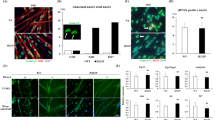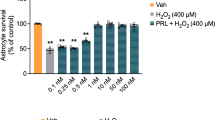Abstract
The tyrosine kinase substrate p36 (calpactin heavy chain) is a calcium-dependent membrane- and cytoskeletal-binding protein. Using an affinity-purified antiserum raised against the p36 heavy chain from bovine adrenal medulla, we have examined the cellular distribution of p36 in developing and adult cerebellum. From immunoblotting, the level of p36 in cerebellum was found to decline during development. In dissociated cell cultures of P4 cerebellum, all cell types were labeled by anti-p36. In vibratome sections from cerebella of P10 rats, anti-p36 stained Purkinje cell bodies strongly and all other cell types less strongly, with the exception of cells in the external germinal layer, which were unstained. By 18 days postnatally p36 was present at higher levels in Bergmann glia and astrocytes of the white matter. In sections of adult cerebella, anti-p36 staining was restricted to Bergmann glial processes and to the processes of a subclass of astrocytes in the granular layer and the white matter. At no developmental stage was anti-p36 staining detectable in axons or dendrites in vibratome sections. These results suggest that p36 plays a role in some aspect of cellular differentiation common to all cerebellar cell types and may have additional functions in astrocytes of the adult cerebellum.
Similar content being viewed by others
References
Burgoyne, R.D. (1988) Calpactin in exocytosis? Nature 331:20
Burgoyne, R.D., Cheek, T.R. (1987) Reorganization of peripheral actin filaments as a prelude to exocytosis. Biosci. Rep. 7:281–288
Cambray-Deakin, M.A., Burgoyne, R.D. (1987) Post-translational modifications of α-tubulin: Acetylated and detyrosinated forms in axons of rat cerebellum. J. Cell Biol. 104:1569–1574
Cambray-Deakin, M.A., Norman, K.M., Burgoyne, R.D. (1987) Differentiation of the cerebellar granule cell: Expression of a synaptic vesicle antigen and the microtubule-associated protein MAP1A. Dev. Brain Res. 34:1–7
Cooper, J.A., Hunter, T. (1983) Regulation of cell growth and transformation by tyrosine-specific protein kinases: The search for important cellular substrate proteins. Curr. Top. Microbiol. Immunol. 107:125–161
Creutz, C.E., Dowling, L.G., Sando, J.J., Vallar-Palasi, C., Whippel, J.H., Zaks, W.J. (1983) Characterization of the chromobindins: Soluble proteins that bind to the chromaffin granule membrane in the presence of Ca2+. J. Biol. Chem. 258:14664–14674
Currie, D.N. (1980) Identification of cell type by immunofluorescence in defined cell cultures of cerebellum. Tissue Culture in Neurobiology. E., Giacobini, A., Vernodakis, A., Shahar, A. (ed.) Raven Press, New York, pp 75–89
Currie, D.N., Dutton, G.R., Cohen, J. (1979) Monolayer cultures of perikarya isolated from postnatal rat cerebellum. Experentia 35:345–347
Drust, D.S., Creutz, C.E. (1988) Aggregation of chromaffin granules by calpactin at micromolar calcium. Nature 331:88–91
Dutton, G.R., Currie, D.N., and Tear, K. (1981) An improved method for the bulk isolation of viable perikarya from postnatal cerebellum. J. Neurosci. Methods 3:421–427
Erikson, E., Tomasiewicz, H.G., Erikson, R.I. (1984) Biochemical characterization of a 34 kilodalton normal cellular substrate of pp60srcand an associated 6-kilodalton protein. Mol. Cell. Biol. 4:77–85
Geisow, M.J., Burgoyne, R.D. (1982) Calcium-dependent binding of cytosolic proteins by chromaffin granules from adrenal medulla. J. Neurochem. 38:1735–1741
Geisow, M.J., Burgoyne, R.D. (1987) An integrated approach to secretion: Phosphorylation and Ca2+-dependent binding of chromaffin granule associated proteins. Ann. N.Y. Acad. Sci. 493:563–576
Geisow, M.J., Childs, J., Dash, B., Harris, A., Panayotou, G., Sudhof, T., Walker, J.H. (1984) Cellular distribution of three mammalian Ca2+-binding proteins related to torpedo calectrin. EMBO J. 3:2969–2974
Geisow, M.J., Hexham, J.M., Dash, B., Johnson, T. (1986) A consensus amino acid sequence repeat in torpedo and mammalian Ca2+-dependent membrane binding proteins. Nature 320:636–638
Gerke, V., Weber, K. (1984a). Identity of p36K phosphorylated upon Rous sarcoma virus transformation with a protein purified from brush borders: Calcium-dependent binding to non-erythroid spectrin and Factin. EMBO J. 3:227–233
Gerke, V., Weber, K. (1984b). The regulatory chain in the p36-Kd substrate complex of viral tyrosine-specific protein kinases is related in sequence to the S-100 protein of glial cells. EMBO J. 4:2917–2920
Ghandour, M.S., Langley O.K., Clos, J. (1983) Immunohistochemical and biochemical approaches to the development of neuroglia in the CNS, with special reference to cerebellum. Int. J. Dev. Neurosci. 6:411–425
Glenney, J.R. (1986) Two related but different forms of 36,000 Mr tyrosine kinase substrate (calpactin) which interact with phospholipid and actin in a Ca2+-dependent manner. Proc. Natl. Acad. Sci. U.S.A. 83:4258–4262
Glenny, J.R., Tack, B.F. (1985) Amino-terminal sequence of p36 and associated p10: Identification of the site of tyrosine phosphorylation and homology with S-100. Proc. Natl. Acad. Sci. U.S.A. 82:7884–7888
Gould, K.L., Cooper, J.A., and Hunter, T. (1984) The 46,000-dalton tyrosine kinase substrate is widespread whereas the 36,000-dalton substrate is only expressed at high levels in certain rodent tissues. J. Cell Biol. 98:487–497
Greenberg, M.E., Edelmann, G.M. (1983) The 34 kd pp60src substrate is located at the inner face of the plasma membrane. Cell 33:767–779
Greenberg, M.E., Brackenbury, R., Edelmann, G.M. (1984) Changes in the distribution of the 34-kilodalton tyrosine substrate during differentiation and maturation of chicken cells. J Cell Biol. 98:473–486
Hexham, J.M., Totty, N.F., Waterfield, M.D., Crumpton, M.J. (1986) Homology between the subunits of S100 and a 10 kDa polypeptide associated with p36 of pig lymphocytes. Biochem. Biophys. Res. Commun. 134:248–254
Lehto, V.P., Virtanen, I., Passivuo, R., Ralston, R., and Alitalo, K. (1983) The p36 substrate of tyrosine-specific protein kinases colocalizes with non-erythrocyte spectrin, p230, in surface lamina of cultured fibroblasts. EMBO J. 2:1701–1705
Owens, R.J., Gallaher, C.J., Crumpton, M.J. (1984) Cellular distribution of p68, a new calcium-binding protein from lymphocytes. EMBO J. 3:945–952
Palay, S.L., Chan-Palay, V. (1974) Cerebellar cortex. Cytology and Organisation. Springer, Heidelberg
Radke, K., Martin, G.S. (1979) Transformation by Rous sarcoma virus: Effects ofsrc gene expression on the synthesis and phosphorylation of cellular polypeptides. Proc. Natl. Acad. Sci. U.S.A. 76:5212–5216
Saris, C.J.M., Tack, B.F., Kristensen, T., Glenney, J.R., Hunter, T. (1986) The cDNA sequence for the protein tyrosine kinase substrate p36 (calpactin 1 heavy chain) reveals a multidomain protein with internal repeats. Cell 46:201–212
Smith, V.L., Dedman, J.R. (1986) An immunological comparison of several novel calcium-binding proteins. J. Biol. Chem. 261:15815–15818
Sudhof, T., Ebbecke, M., Walker, J.H., Fritsche, U., Boustead, C. (1984) Isolation of mammalian calectrins: A new class of ubiquitous Ca2+-regulated proteins. Biochemistry 23:1103–1109
Author information
Authors and Affiliations
Additional information
This work was supported by project grants to R.D.B. from the Medical Research Council of the United Kingdom.
Rights and permissions
About this article
Cite this article
Burgoyne, R.D., Cambray-Deakin, M.A. & Norman, KM. Developmental regulation of tyrosine kinase substrate p36 (calpactin heavy chain) in rat cerebellum. J Mol Neurosci 1, 47–54 (1989). https://doi.org/10.1007/BF02918890
Issue Date:
DOI: https://doi.org/10.1007/BF02918890




